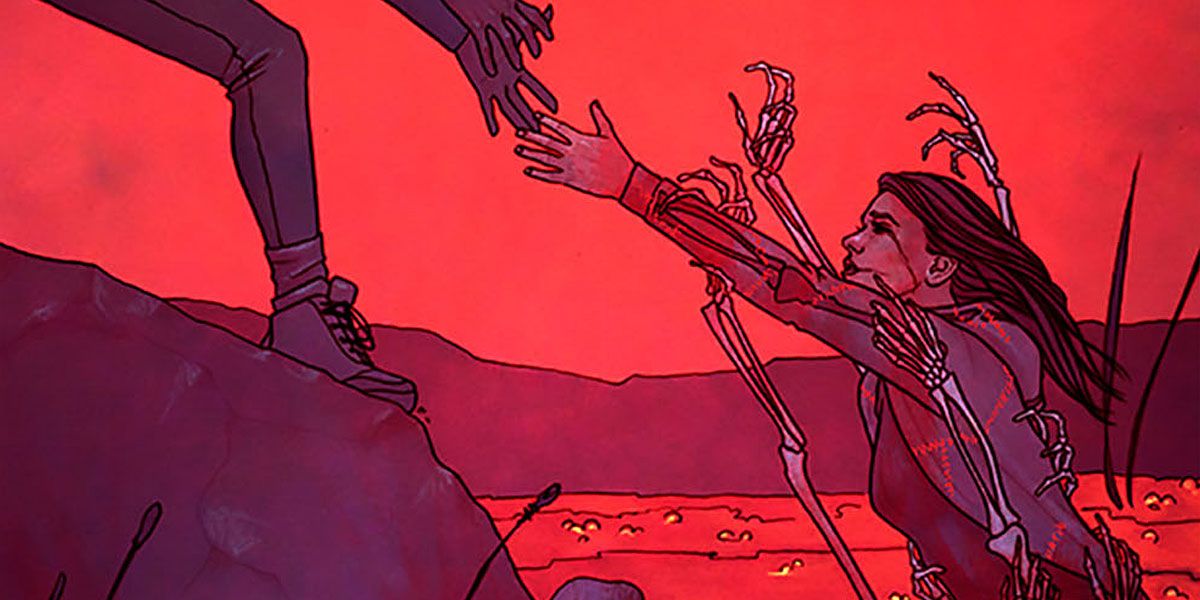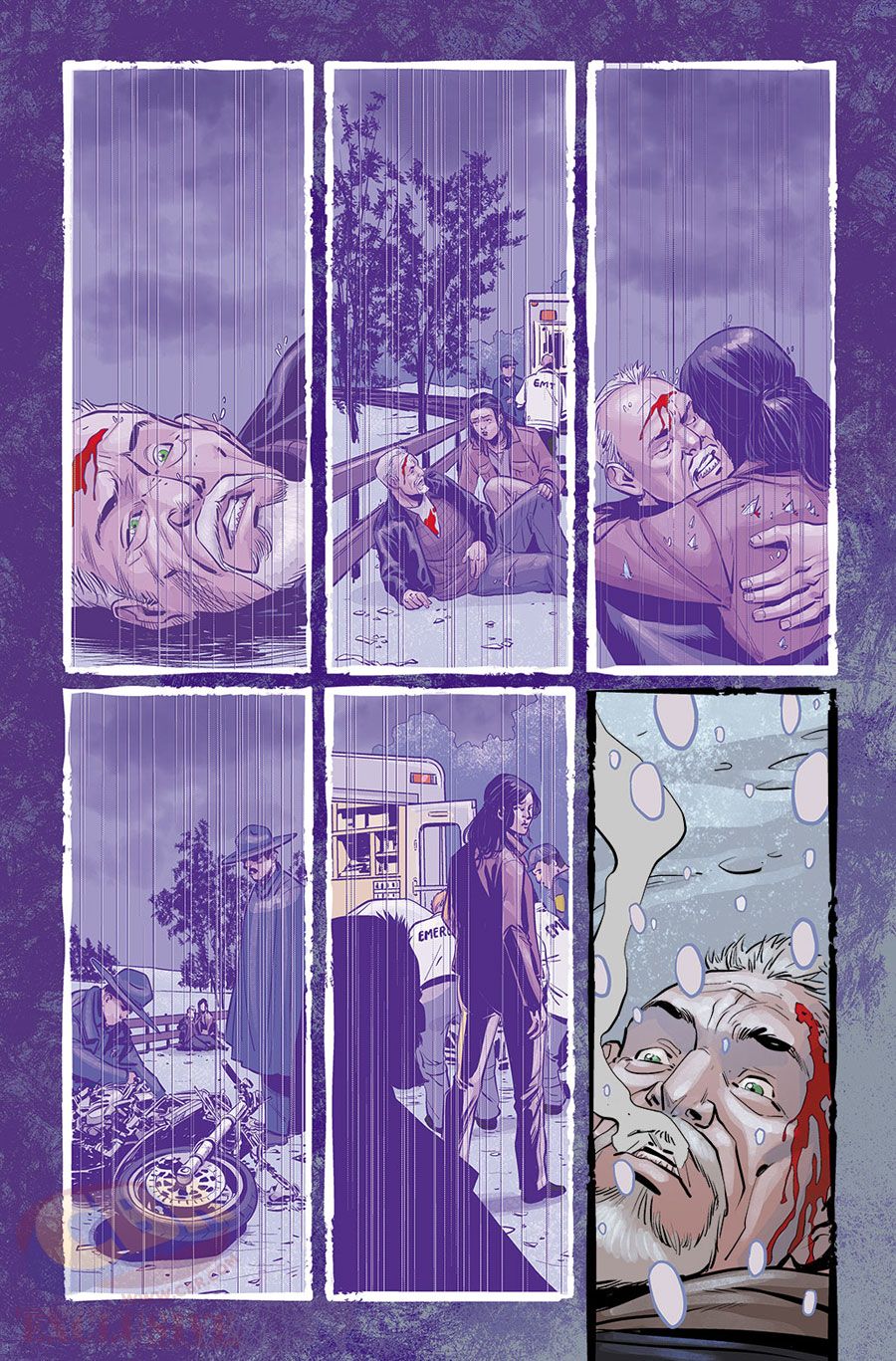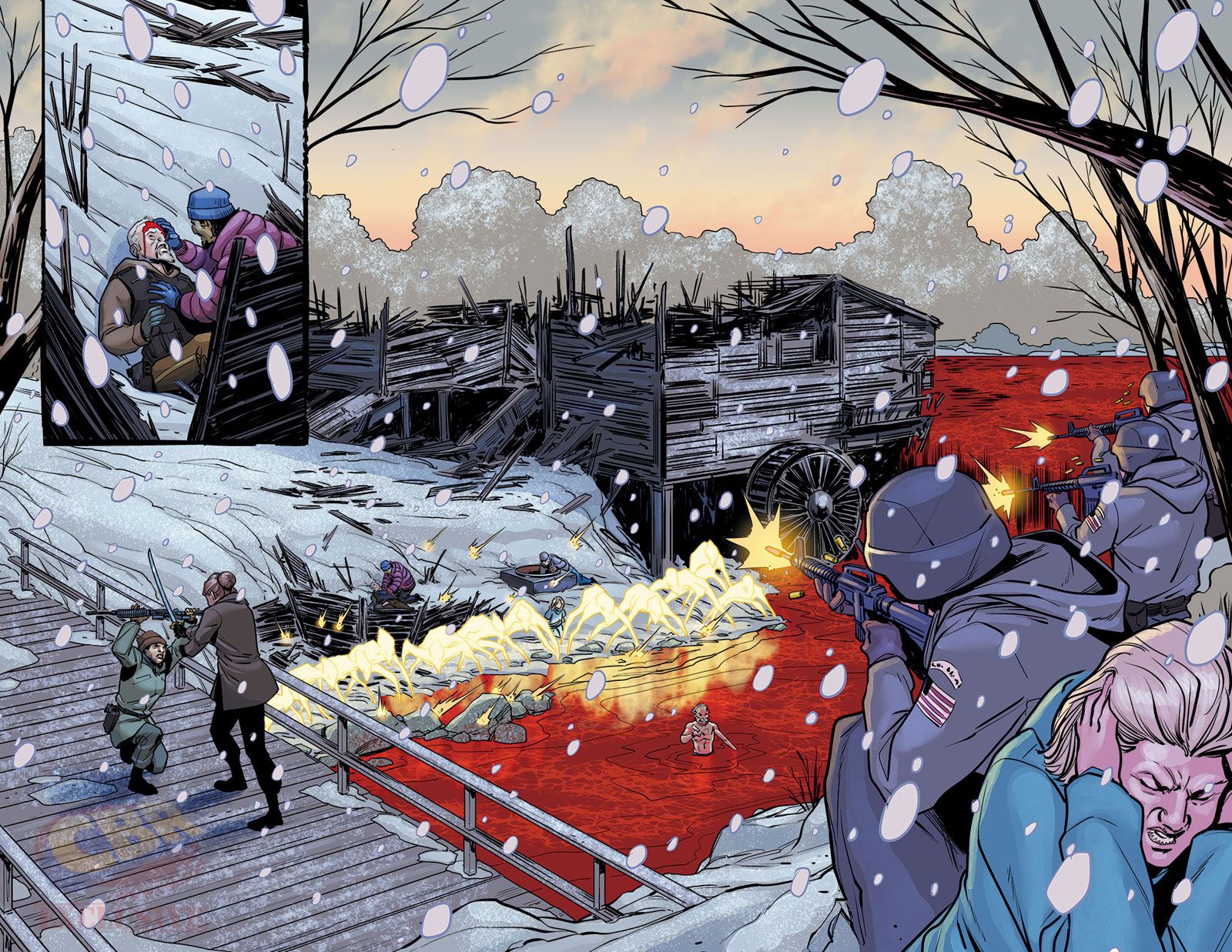Human beings have a natural antipathy towards death. It literally takes everything from us, so we often view it as something to be feared and defied instead of as a natural part of existence -- which, if taken too far, can have dangerous and even apocalyptic consequences. In 2012, writer Tim Seeley and artist Mike Norton began examining some of those consequences in their creator-owned rural horror/noir Image Comic series “Revival,” set in a fictionalized version of Wausau, Wisconsin where one day all of the town's recent dead mysteriously returned to life. These “Revivers” turned life upside down in Wausau, and now, almost five years later, the town is on the brink of destruction as Seeley and Norton bring “Revival” to a close with issue #47.
All hope is not lost in fictional Wausau, though. The town's defenders, which include police officer Dana Cypress and her Reviver sister Martha, aka Em, have banded together with unlikely allies aging fitness guru Lester Majak to undo the mysterious and unnatural phenomenon plaguing their town. Ahead of the series' final issue Seeley and Norton joined us for a discussion about the origins of these important characters, the larger themes of “Revival," and what's next for the two creators.
CBR: "Revival" debuted almost five years ago, and now we're just days away from the release of the 47th and final issue. How does it feel to have this story come to a natural conclusion?
Mike Norton: Good. Sad. Weird. We’ve known this day would come since we started issue one, and I don’t think either of us knew what the end would feel like. We knew how the story would end, just not how we would feel at the end.
Tim Seeley: I'm relieved in a lot of ways, mostly that we got to the end without any major hiccups. Even more relieved that the story worked out really well. When you're in the middle of it, it can be hard to tell if everything is going to line up.
At the same time, I feel kinda bummed out, which I didn't expect.
"Revival" explored the relationships that made up an entire small town, but one of the biggest, and perhaps the driving dynamic, was the one between the two Cypress sisters, Dana and Em. Was that bond between sisters always going to be the central focus of the book? And what made you want to focus on that bond?
Norton: I don’t know if it was Tim’s intention from the very beginning, but from the first issue, we knew that’s what it would be. The Cypress family relationship is the story of “Revival.” I guess you could say that’s how we’re different from the rest of the “dead come back” stories.
Seeley: Right, yeah this wasn't about surviving, which is what 99% of “zombie fiction” is about. It was about living with people. We wanted to explore that subject on a macro level with the town, but also on the micro level, in relationships most of us have experienced in our lives -- the relationships with our families.
I picked “sister” as the central bond, mostly because I have two brothers, and the relationship I have with them is one of the most important things in my life. I made the characters women, mostly because I'm endlessly fascinated by them, but also because I've seen some really interesting dynamics between real life sisters that I wanted to play around with.
What went into the development and design of the Cypress sisters? Were Dana and Em always going to be and look like who they were in "Revival" #1?
Norton: I think Tim was pretty clear on Em from the beginning. He actually drew a picture of her before I even started. She’s not too different from another character he created when he was younger. Dana was my creation. She was originally going to be a guy.
Seeley: [Laughs] Yeah, Dana started the story as "Dane." True story! I made up Em when I was 16, and she looks remarkably similar to my original design from 23 years ago, minus the terrible school girl skirt.
The central mystery that influenced much of the action in "Revival" suggests that one of the central themes of the book is the acceptance of death. Is that what you were aiming for?
Norton: That is definitely one of the main themes. Of all the hardships humans endure, the loss of a loved one’s life (or dealing with your own mortality) is one of the biggies. How we accept it makes us who we are.
Seeley: I'm sure my obsession with death is pretty obvious to anyone whose read any of my stuff, or seen my music collection. “Revival” is definitely about mortality -- why we have to die, why it it has to hurt the people who love us, and how it inspires everything we do.
One character I felt best exemplified the idea of acceptance of death in "Revival" was Lester Majak and his attempts to defy aging. He was a character who on the surface seemed almost humorous, but was much more dangerous and dark when you delved into him. What inspired the creation and look of Lester?
Norton: Tim was the brains behind Lester. He’s sort of an evil Jack Lalane.
Seeley: Yeah, Lester was inspired by an interview I had read with Jack Lalane in the back of an airline magazine. It was a great interview, which began as a puffpiece, but sort of evolved into this observation about how Jack's fight for fitness was really a denial of mortality. I combined that basic idea with this 80-year-old Lothario I met at a bar in San Francisco, who had lost a lot of his ability to speak from a stroke, but had lost none of his charm with the ladies.
Lester is, of course, just one of a handful of many characters that called your version of Wausau home. Looking back, who are some of your favorite characters?
Norton: Dana is my favorite overall, but Tim populated the town with lots of real people to like. Mrs. Vang, Cooper, Jeanie Gorski. I’d say the strength of the writing is shown in that I actually dislike the villainous characters we created. Like, I really hate them.
Seeley: [Laughs] I always love the villains, so I think that's why Blaine Abel, the rather tragic exorcist and snowmobile repairman always stood out to me. I also love non-villain Wayne Cypress, based a bit on my own dad, and Weaver Fannie, the samurai Amish woman.
Mike, what always struck me about the visuals of "Revival" was the moments of action and excitement were great, but where you really shined was the character design, acting, and the tone, whether it was humorous, creepy, or horrific. Looking back, what was it like to bring this book to life on a month by month basis? What are some of the things you'll miss about it? And what are some of the things you won't miss?
Norton: The thing I won’t miss is that even with something you love, it becomes a grind after a while. Keeping up the constant schedule for five years was tougher than I thought it would be. Incredibly rewarding, but hard. I will miss the characters and setting. I love drawing characters acting. It’s by far my favorite thing to draw... well, besides rubble. And pugs. I’m really happy you thought it showed.
Seeley: The dude pulled that shit off every month for five years! How is Mike not artist of the year five years running?!
Let's wrap up by teasing what fans can expect from "Revival" #47, the series' finale. What are some hints you can offer about what people will see? And is this a series where you might revisit this world and it's surviving characters later for some stories, like Tim did with "Hack/Slash?”
Norton: I really don’t see us revisiting, but as Tim showed me with the “Chew” crossover, I should never say never. The story is done, and it’s the one we wanted to tell. I don’t think there’s anything more we want to say.
Seeley: I think 47 pulls together all the threads we've been rolling out over the course of the series, and I think it does it in a pretty unpredictable way. I hope so, at least. I think it also shows that we really did have a plan, and that the idea of “threads” is actually very much a thematic device, almost like veins winding through this big, fleshy body we created.
I'm not sure if I'd revisit it -- at least not in this form. It's definitely a contained shape as it is. I can see some of the characters showing up -- maybe I'll do "Amish Samurai Atlee meets Cat & Dog Investigations."
Norton: I’m so happy people read and continue to read it. I’m proud of what we did. I think it’s one of the best things Tim has ever written, and I feel lucky and honored to have been part of it.
Seeley: It was an honor for me, as well. Norton proved his place in the pantheon with this book. Thanks so much to our readers, to the few members of the comics press who kept talking about “Revival” (like you, Dave), and to our collaborators Jenny, Crank!, Juan and Mark. Also, many, many thanks to Image Comics, for existing, and for publishing our book. We owe Eric Stephenson and the production staff there many beers.
Tim is currently writing "Nightwing" and Mike, I believe you're drawing the current "Archer & Armstrong” series for Valiant, but what's next for you guys in terms of creator-owned books now that "Revival" has wrapped? Have you guys already begun to develop or think about potential projects?
Norton: I actually just wrapped up “Archer and Armstrong," too! So hey, if anybody needs me to draw Spider-Man...
Seriously, though, I do have ideas for what I want to do, but I’m taking it a bit slower now for a few months. I have a story I’m writing and drawing for Dave Kellett’s webseries “Drive,” and I’m drawing an issue of Felicia Day’s “The Guild.” I have more plans for “Battlepug” and “The Answer!” and I am cooking up a creator-owned series with an old pal of mine. I’m excited!
Seeley: Whew. All I know for sure is that I'm pretty beat. I'm on “Nightwing” for the long haul, and I definitely want to do a creator-owned book to follow up “Revival,” but I'm a little hesitant to jump into another massive commitment like that. It'd be nice to write something, I dunno... dumb, after something so complex and involved. Like, just wall-to-wall sex and violence and fart jokes. [Laughs]



